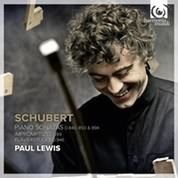The present release marks Paul Lewis’ return to solo Schubert since his first two discs for Harmonia Mundi. Unleashing great ferocity and brio at the outset of the D major sonata’s first movement, Lewis soon introduces elongations of phrase and tempo modifications that seem fussy rather than purposeful, without the tension and release that Richard Goode and Clifford Curzon generate. However, the melodic trajectory and flexible give and take between hands conveys more organic fluidity in the Con Moto, while the Scherzo stands out for Lewis’ superb articulation and thematic characterizations. More than a few arch and mincing gestures sneak into the Rondo finale (the swooning G major theme), in contrast to Goode’s slightly faster, more militant reading.
The difficult-to-sustain G major sonata opening movement holds interest by way of Lewis’ gorgeous timbral control, along with an animated, eloquently shaped Andante. The Menuetto boasts welcome lilt and earthy swagger, plus a few gratuitous expressive touches. While the concluding Allegretto is relatively steady in tempo, Volodos’ stronger rhythmic underpinning and more effective, effortless textural differentiation win the day.
The two-movement, unfinished “Relique” proves the prize among Lewis’ sonata offerings: note the haunting tonal quality he brings to the first movement’s repeated triplet figures and the subtle accentuation that sharpen the composer’s seemingly strange modulations. Lewis’ pronounced dynamic contrasts and long-lined momentum bring out all of the Andante’s drama and mood swings.
There’s also much to admire in Lewis’ D. 899 Impromptus and D. 949 Klavierstücke. Notice the hushed, disembodied quality of the C minor Impromptu’s single line theme, Lewis’ vivid contouring of the E-flat Impromptu’s uneventful left-hand accompaniment, or the unusual yet convincing legato phrasing that elucidates the C major Klavierstücke’s rhythmic asymmetry. I also like how Lewis’ slightly offhand and brisk treatment of the E-flat major Klavierstücke truly honors the composer’s Allegretto marking–and that also applies for the pianist’s uncommonly headlong central minor-key section.
The E-flat minor Klavierstücke’s outer-section climaxes positively explode in Lewis’ hands, while the central Allegro’s melodic embellishments make their points through Lewis’ variegated tone colors and articulations, rather than via tempo modification. At the same time, Lewis’ elegantly phrased G-flat Impromptu doesn’t quite match the transparency and ideal melody/accompaniment balances that disparate pianists such as Uchida, Lupu, Gieseking, Horowitz, and (best of all) Schnabel achieve.
Harmonia Mundi’s opaque, overly resonant pickup tends to flatten out accents while smoothing out rapid passages such as the E-flat and A-flat minor Impromptus’ right-hand patterns. While Lewis’ interpretations may not surpass favorite versions of these same pieces, his Schubertian mastery undoubtedly commands the respect and attention of piano lovers.
































